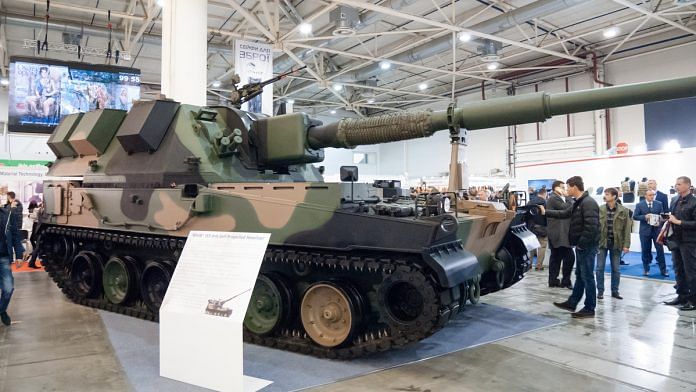The Rs 4,366 crore contract for the K9 Vajra is meant to arm 18 regiments of the Indian Army, and replace the 50-year-old 105-mm Abbott.
New Delhi: Defence Minister Nirmala Sitharaman will Friday preside over the induction of the heaviest gun the country has ever had, assembled in India as part of a deal between a domestic firm and a South Korean counterpart.
In the sparse hills of Devlali near Nashik, Maharashtra, the (K9) Thunder will peal.
The K9, called the Vajra in its customised Indian version, is a tracked and self-propelled piece of artillery originally developed by Samsung for the South Korean military.
Although the Vajra looks like a tank, it is a 155-mm/52-calibre cannon mounted on tracked chassis — the millimetre figure being the size of the shell it can fire, and the calibre the length of the barrel it fires from.
By common consent, military aficionados will call the induction “the breaking of the Bofors jinx”.
The Bofors guns, with their “shoot-and-scoot” technology — the ability to fire a shell and move away from its location by up to three kilometres — were the last piece of artillery that India imported. It has been 31 years since.
Over the years, Bofors has come to be synonymous with corruption amid allegations — raked up by rivals of the Congress to this day — that the then Prime Minister Rajiv Gandhi was bribed by the Swedish gun manufacturer. India has not been able buy heavy guns since for bureaucratic fear and political apathy.
Also read: Artillery weapons including K9 Vajra & M777 howitzers to be inducted into India’s defence
Replacing half-a-century-old guns
The Rs 4,366 crore contract for the Vajra is meant to arm 18 regiments, and replace the 50-year-old 105-mm Abbott, which India inherited from the British in 1964.
Mounted on a tank chassis, Abbott was India’s first and only self-propelled gun.
The Vajra is now being assembled — in a ‘Make in India’ initiative — by Larsen and Toubro from completely knocked-down kits (CKDs) imported from South Korea, at facilities in Talegaon, Maharashtra, and in Hazira, Gujarat.
“After 1971, till the year 2000, there was only one major field artillery induction which was 155-mm/39-calibre field howitzer 77B (Bofors),” a Defence Ministry note accessed by ThePrint says.
“It had a maximum range of 24,000 metres (24 km) with HE (high explosive ordnance) and 30,000 metres (30 km) with base bleed shells. It could fire HE, smoke and base bleed shells,” the note adds.
Base bleed shells are bombs that have fire in their bottoms while being propelled through the air.
Also read: The SiG 716 rifle could be the replacement for Indian Army’s INSAS
For the armoured divisions
The K9 Vajra is meant for armoured divisions, which form a part of the Indian Army’s strike corps.
The Army has three strike corps — 1, 2 and 21 — whose mission in war is to scythe through the western border with Pakistan. A fourth strike corps, 17, is limping. It is headquartered near Ranchi and tasked with duties in the mountains near the China frontier.
Along with the K9 Vajra, the Army will also induct at the Devlali Artillery ranges Friday the M777 ultra light howitzers.
These 155-mm/39-calibre guns can be airlifted, underslung from the Chinook helicopters (that the IAF has contracted), or stuffed into the C130J Hercules transporters that are in the IAF fleet.
Tow trucks to carry the artillery pieces are part of the package.
The Indian Army had a Field Artillery Rationalisation Plan (FARP) to give itself firepower, a weak area for India in the 1999 Kargil War despite the Bofors.
“In the 21st century, artillery once again pushed for modernisation,” says the ministry note.
In the plan now, the Indian Army is looking at a firepower field that will be new by 2022. The K9 Vajra (Thunder) is part of that plan. The other pieces of fire-spitting artillery are an upgunned 155-mm/45-calibre Soltam (Israel origin), a 155-mm/45-calibre Dhanush that is being derived from hitherto archived technology-transfer documents from the Swedish maker of Bofors, and another gun of the same measurements to be made by the Ordnance Factory Board.
It is the K9 Vajra (Thunder), however, that will be the mainstay. A regiment of artillery has about 20 guns. So far, a piece of artillery needed a seven-member crew. Inside the Vajra, its three-member crew will be told on computer screens where, how and what to fire.





Commitment and technology happens to be the DNA of this organisation. I am sure that in the future the Indian defence can look forward to introduce many more such modern weapons platform by patnering with this organisation. A true Make In India Company.